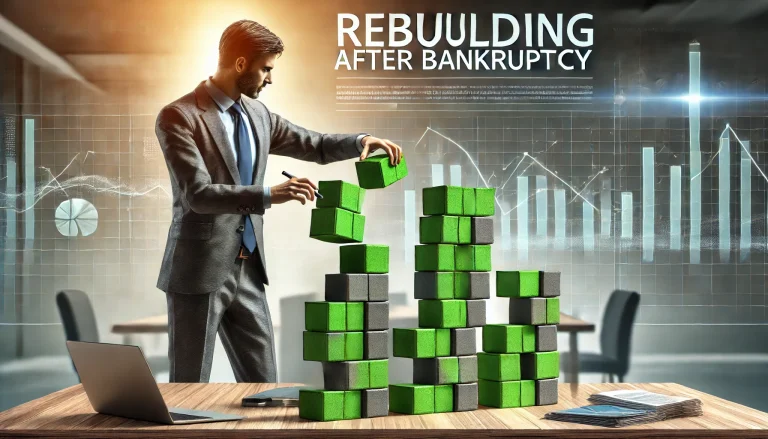Bankruptcy offers a fresh start for those overwhelmed by debt, but it can also leave emotional and financial scars. However, rebuilding after bankruptcy is entirely possible with a strategic approach and careful planning. By understanding the steps involved and committing to positive financial habits, individuals can regain their financial stability and confidence. This guide offers a step-by-step approach to help you rebuild after bankruptcy and achieve long-term financial health.
Understanding the Impact of Bankruptcy
Before starting the recovery process, it’s essential to understand how bankruptcy affects your financial life. For up to ten years (for Chapter 7) or seven years (for Chapter 13), bankruptcy remains on your credit report. During this time, it may be more difficult to get loans, credit cards, or even rent an apartment. However, the impact of bankruptcy diminishes over time, especially as you start building a history of responsible financial behavior.
Embrace the Fresh Start: Accepting Your Situation
Bankruptcy can be emotionally challenging, but it’s important to view it as a fresh start. The bankruptcy process wipes out many debts and gives you an opportunity to rebuild. To move forward, you must first accept your circumstances.Instead of focusing on the past, shift your attention toward building a brighter financial future.
Create a Post-Bankruptcy Budget
A key element in financial recovery is creating and sticking to a realistic budget. Post-bankruptcy, it’s crucial to manage your income and expenses carefully to avoid falling back into debt.
- Keep Track of Your Income and Expenses: List all of your income sources and keep tabs on every dollar you spend. You will be able to see your financial situation clearly as a result.
- Cut Unnecessary Expenses: Reduce discretionary spending and focus on necessities. By identifying areas where you can cut costs, you can better manage your financial obligations.
- Set Financial Goals: Set realistic short-term and long-term financial goals, such as building an emergency fund or saving for a major purchase.
Start an Emergency Fund
One of the key reasons people fall into debt is a lack of savings for unexpected expenses. To avoid future financial setbacks, it’s essential to start building an emergency fund. This fund should cover at least three to six months’ worth of living expenses to protect you from relying on credit cards or loans during emergencies.
- Set Small, Achievable Savings Goals: Start by saving small amounts each month. Even $50 or $100 set aside consistently can grow into a healthy emergency fund over time.
- Automate Your Savings: Consider setting up automatic transfers to your savings account to ensure consistent growth.
Rebuild Your Credit Score
Bankruptcy damages your credit score, but with disciplined action, you can rebuild it. The first step is understanding your credit report and working toward positive credit behaviors.
- Review Your Credit Report: Obtain a free copy of your credit report from all three major credit bureaus (Equifax, Experian, and TransUnion). Make sure that every debt that has been discharged is accurately documented as satisfied.
- Pay Bills on Time: Timely bill payments account for a significant portion of your credit score. Make sure all future payments, including rent, utilities, and any remaining debts, are made on time.
- Apply for a Secured Credit Card: A secured credit card is one of the easiest ways to rebuild credit after bankruptcy. With a secured credit card, you deposit a sum of money as collateral, and this amount serves as your credit limit. Use the card responsibly and pay off the balance in full each month to demonstrate positive credit behavior.
Consider a Credit-Builder Loan
A credit-builder loan is another tool for improving your credit after bankruptcy. While you make monthly payments on this kind of loan, the lender keeps the loan balance in a savings account. Once the loan is fully paid off, you receive the money, and the lender reports your timely payments to the credit bureaus, helping boost your credit score.
Avoid High-Risk Financial Products
After bankruptcy, you may be tempted to take out loans or credit cards with high interest rates to rebuild your credit, but these can be risky. High-interest debt can quickly spiral out of control, putting you in a cycle of borrowing and repayment. Avoid payday loans, subprime credit cards, and high-interest personal loans that may worsen your financial situation.
- Stick to Secured Products: If you’re looking to rebuild credit, stick to secured credit cards or loans with manageable terms.
- Read Terms Carefully: Always read the terms of any financial product to understand fees, interest rates, and repayment obligations.
Monitor Your Credit Regularly
Once you start rebuilding credit, it’s important to monitor your progress regularly. You can check your credit score through free services or by purchasing credit monitoring services. Keeping an eye on your score will help you see how your financial habits are improving and alert you to any potential errors or identity theft.
- Watch for Errors: Discrepancies in your credit report, such as accounts that should have been discharged in bankruptcy, can hurt your score. Dispute any errors with the credit bureaus to ensure your report is accurate.
Live Within Your Means
One of the primary lessons of bankruptcy is the importance of living within your means. Rebuilding your finances requires adopting smart financial habits and avoiding unnecessary debt.
- Focus on Needs, Not Wants: Prioritize essential expenses such as housing, utilities, and food over luxury purchases. Establish financial discipline by resisting the urge to overspend.
- Use Cash or Debit: Instead of relying on credit, try to use cash or debit for daily expenses. This will help you stay within your budget and prevent you from accumulating new debt.
Seek Financial Education and Support
Rebuilding after bankruptcy is not something you have to do alone. There are many resources available to help you learn more about financial management and support your recovery journey.
- Credit Counseling: Enroll in credit counseling or personal finance classes to enhance your understanding of budgeting, credit repair, and debt management.
- Seek Professional Advice: A financial advisor or bankruptcy attorney can offer personalized advice on how to rebuild your financial life and avoid future debt issues.
Conclusion
Rebuilding after bankruptcy is a gradual process, but with the right strategies, it is possible to restore your financial health and confidence. Start by creating a realistic budget, building an emergency fund, and taking proactive steps to rebuild your credit. Avoid high-risk financial products and adopt smart financial habits, such as living within your means and paying bills on time. Regularly monitor your credit report and stay informed through financial education. Bankruptcy is not the end of the road, but rather the beginning of a new chapter where financial stability and independence are achievable with discipline and careful planning. By following these steps, you can recover from bankruptcy and build a secure financial future.


